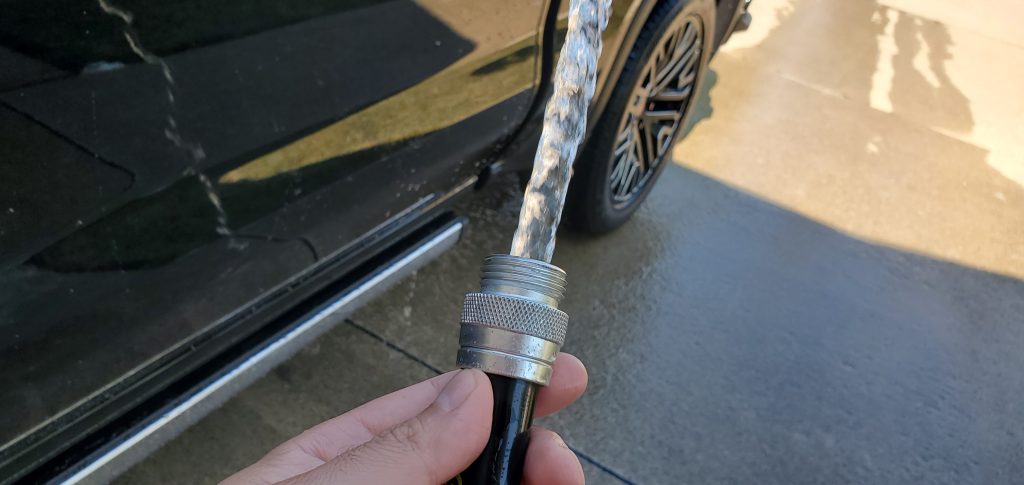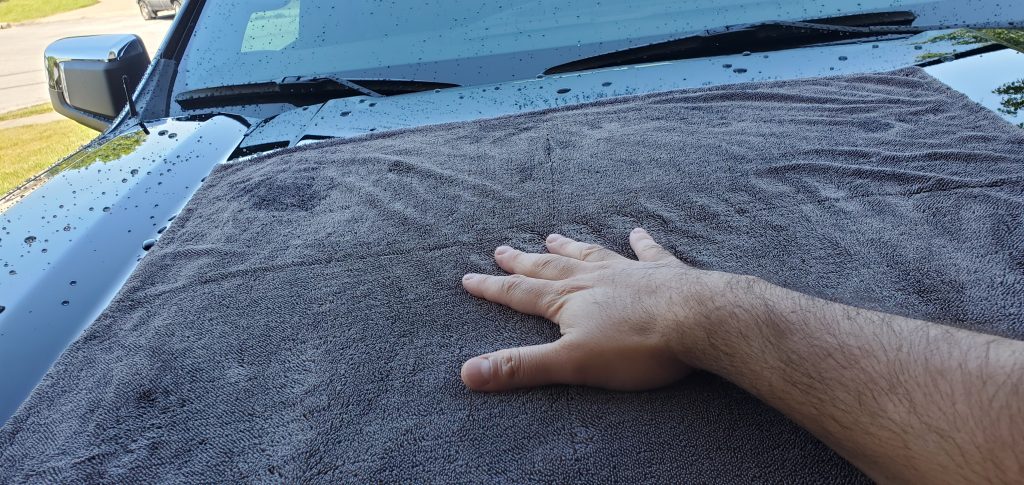Drying Tips for Coated Vehicles
by Mike CardenasIf your vehicle is coated with a ceramic coating then you already know that upon washing it, it tends to bead a lot of water when you rinse the vehicle at the end of your wash process. Of course, we all love the beading action that coatings provide, but why not use that hydrophobic effect to work for you? Ceramic coatings provide some level of protection against light swirls and scratches, but they are not a suit of armor. Just like a non-coated vehicle, abrasion can always be an enemy on paint. So how can you dry your coated vehicle while minimizing abrasion? Here are two tips that we as professional detailers use when drying a coated vehicle.
The Water Drying Technique

One of the ways to easier drying of coated vehicles is a trick commonly known as “water drying” or the “waterfall effect”. This technique is recommended for your final rinse before drying.
Here’s how it works
- Using a garden hose, you will have to simply remove any hose gun attachments on the hose.
- Next, hold the water hose close to the panel to let the water stream fall gently on the panel. This is to avoid splashing on the surface.
- Lastly, glide the water stream across the panel to remove as many water beads from the panel as possible.
- Do this for each panel or sections of the vehicle.
When done correctly you will see that as you glide the water across a panel, the panel will have very minimal water beads left behind. This will make drying extremely easy and efficient. Often times, allowing you to dry your vehicle with only one towel. So on to the next tip, safer towel drying.
The Blotting or “Pat Dry” Method

This method is extremely helpful for safely drying any vehicle, whether they are coated or not. The technique was made popular prior to arrival of ceramic coatings. We all used this method to dry vehicles after meticulous paint correction processes that used to take us 2 to 3 times as long as they do today. So its no surprise that this simple technique is still commonly used today.
Here’s how it works
- Simply lay the towel completely flat onto the surface to be dried.
- Next, gently pat the towel on the surface to aid in soaking up the water.
- Pull the towel away and repeat until the entire section has been dried.
- Lastly, leave the lower portions of the vehicle until the very last.
If you’ve ever dried your vehicle in the past and found that certain sections of the towel were extremely wet, this method will remedy that. Using the blotting or pat-dry method maximizes the use of the entire towel, evenly soaking up water more efficiently. As a result of not dragging the towel all over the place, if debris or something gets stuck onto the towel accidentally, by blotting it will greatly minimize the result of swirls and/or scratches. In the video below, you will see the Griot’s Garage PFM Terry Weave Drying Towel. Its a towel I have been using for years as my go-to drying towel and it holds up to 6 pounds of water weight!
Lastly, a blower drying system is something I am often asked about by my clients. Using a blower dryer system is a great way to safely dry your vehicle. Especially for helping to dry wheels, trim and areas that hold water. When using these blower systems, it is still necessary to use a drying towel. Use these tips and they will help you in drying your vehicle safely and efficiently.








I always thought that the less touching of the finish, the better. I’ve used a dedicated blower for getting 95+% of the water off the car, and then dabbed off whatever is left. Is there a downside to this method?
There’s no downside at all. If you have a blower, its a great way to eliminate the amount of contact with the paint finish.
Perfect; thanks!
Blowing before drying is a no brainer. You can find cheap leaf blowers at Home Depot or Lowes starting at $30 that do a fine job. Finish off with blotting method. A few shots of detailing spray on the microfiber towel and steaks and spots disappear.
As a pro shop we find that the blotting method of hand drying FIRST, followed by blow drying AFTER to remove all remaining water (particularly in crevices and voids) is more efficient, particularly prior to running compounds and polishes mechanically.
No mention of the water blade, or jelly blade (squeegee)? We can knock 80-90% of the water of in minutes and follow with a drying towel to blot up what’s left. Finally blowing the water out of crevices with our shop vacs.
I personally don’t prescribe to using such blades because of their abrasive nature. It’s risky dragging them on a painted surface when trying to minimize damage during the drying process.
I love the blade it’s never scratched any of my costumers car an I’ve been in business for 3yrs it works on windows too
15 years here, and still using the same blade.